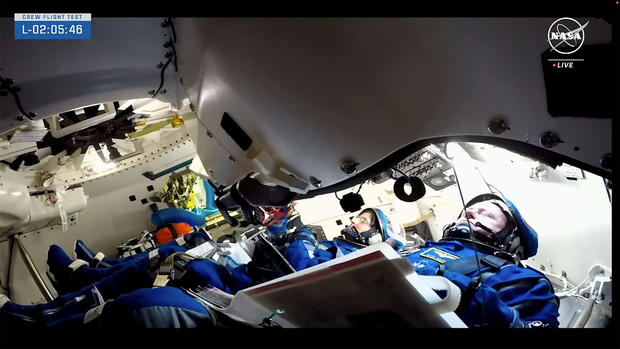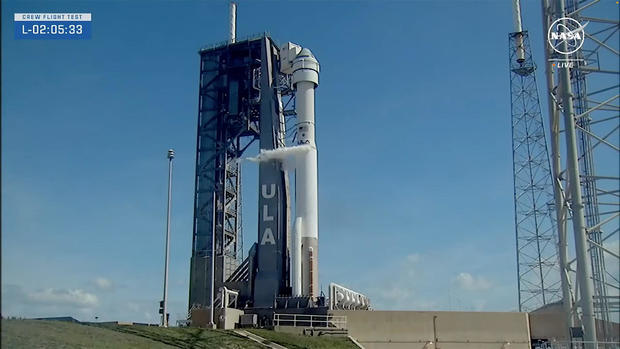
Boeing Starliner’s first astronaut flight halted at the last minute
The seemingly star-crossed Boeing Starliner — within minutes of its long-delayed blastoff on the spacecraft’s first piloted test flight — was grounded again Saturday when one of three redundant computers managing the countdown from the base of the launch pad ran into a problem, triggering a last-minute scrub.
Engineers initially were told to set up for another launch try Sunday, at 12:03 p.m. EDT, assuming the problem could be resolved in time. But NASA later announced the team would pass up a Sunday launch try to give engineers more time to assess the computer issue.
The Starliner’s test flight includes rendezvous and docking with the International Space Station. Based on the station’s orbit and the Starliner’s ability to to catch up, the next two launch opportunities after Sunday are Wednesday, at 10:52 a.m. EDT, and Thursday, at 10:29 a.m. NASA said the agency would provide an update Sunday.
with a pressure relief valve in their Atlas 5 rocket, and a helium leak in the capsule’s propulsion module.
Those problems were resolved, and after a few minor snags Saturday, the countdown appeared to be ticking smoothly toward a planned launch at 12:25 p.m. EDT. But 10 seconds after the countdown came out of a planned hold at the T-minus 4-minute mark, the clocks suddenly stopped ticking.
Launches to the International Space Station are timed for the moment the Earth’s rotation carries the pad into alignment with the space station’s orbit, a requirement when trying to rendezvous with a target moving at nearly 5 miles per second. An unplanned hold in the countdown for such missions immediately triggers a minimum 24-hour launch delay.
NASA
Tory Bruno, CEO of United Launch Alliance, builder of the Atlas 5 rocket, said the issue Saturday involved one of three networked computer racks in a building at the base of the launch pad. Each rack features multiple systems, including identical circuit boards that operate together as a “ground launch sequencer,” managing the final steps in a countdown.
The GLS computers manage events like the retraction of umbilicals and the firing of explosive bolts that free the rocket from the pad for takeoff, and all three have to be in perfect agreement for a countdown to proceed.
During Saturday’s launch attempt, the countdown ticked down to T-minus 4 minutes and then entered a planned four-hour hold. When the countdown resumed four minutes prior to blastoff, one of the three GLS circuit boards took longer than expected to synch up with the other two. That was enough to trigger an automatic hold at the T-minus 3-minute and 50-second mark.
NASA
Engineers planned to begin troubleshooting after draining the Atlas 5 of its liquid hydrogen and oxygen propellants and gaining access to the computer room. A decision on how to proceed depended on isolating the problem and replacing and testing any suspect components.
The launch team, while disappointed, took the latest delay in stride.
“You know when you’re playing a game and you get a bad call, you’re a little irritated at first, or a little frustrated at first, but you immediately focus on the next pitch and that’s what our teams do, they’re focused on the next pitch,” said Mark Nappi, Boeing’s Starliner project manager.
“As soon as we went into the launch scrub and launch turnaround, I looked out into the control room and everybody had their heads down, working the procedures to get ready for another attempt tomorrow.”
Said Bruno: “The disappointment lasts for about three seconds. And then you just immediately get busy and do your job. We’ll be back.”
Whenever it takes off, the long-awaited flight will be the first piloted launch of an Atlas 5, and the first for the Atlas family of rockets since astronaut Gordon Cooper took off just a few miles away on the Mercury program’s final flight 61 years ago.
Likewise, it will be the first piloted flight of the Starliner, Boeing’s answer to SpaceX’s Crew Dragon, an already operational, less expensive spacecraft that has carried 50 astronauts, cosmonauts and civilians into orbit in 13 flights, 12 of them to the space station, since an initial piloted test flight in May 2020.
NASA funded development of both spacecraft to ensure the agency would be able to launch crews to the outpost even if one company’s ferry ship was grounded for any reason.
Already running years behind schedule because of budget shortfalls and a variety of technical problems that cost Boeing some $1.4 billion to correct, NASA had hoped to get the Starliner into orbit on May 6. But the launch was scrubbed when United Launch Alliance engineers detected trouble with a pressure-relief valve in the rocket’s Centaur upper stage.
The Atlas 5 was hauled off the pad and back to ULA’s Vertical Integration Facility, where the Centaur valve was quickly replaced. But in the wake of the launch scrub, Boeing engineers saw signs of a small helium leak in the Starliner’s propulsion system.
The leak was traced to a flange in plumbing that delivered pressurized helium to drive one specific reaction control system jet in the Starliner’s service module. The leak was characterized as “very small,” but engineers needed to show it would not drastically worsen in flight and cause problems for other thrusters.
After extensive analysis and testing, mission managers concluded the spacecraft could be safely launched as is, saying that even if the leak rate was a hundred times worse than so far observed, it would not pose a risk to the crew or the mission. As it turned out, the leak rate remained within acceptable limits Saturday.
More
More
Source: cbsnews.com
